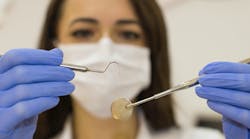How to establish an infection control plan and ensure patient and team safety
Optical infection control practices in dentistry are essential to ensure the safety of both the dental team and the patients. That is why, in addition to rigorous infection control education of dental professionals during basic training, the American Dental Association (ADA) and the Centers for Disease Control and Prevention (CDC) routinely provide updated guidelines for dentists on how to minimize cross-infection in their practices. Now, with the COVID-19 pandemic still raging on, dental health-care providers have an increased responsibility to ensure a safe and infection-free environment for their team and patients. This article offers an overview of the infection control guidelines provided by the CDC1 for dental settings in seven areas and the steps dental professionals need to undertake to keep their patients safe and healthy.
No. 1: Administrative measures
Each dental practice must have an individualized infection control plan prepared according to evidence-based practice guidelines, as well as the state and federal regulatory authorities. Dentists must assign at least one person who has undergone training in infection prevention to be responsible for implementing the infection control plan in the office. More importantly, each practice must have systems in place to detect and manage potentially infectious diseases well in time, in addition to supplies and equipment that are necessary for infection control.
No. 2: Education and training of the dental team
All dental professionals must undergo routine training to learn basic infection spread and control, as well as patient safety measures in dental settings. These exercises can be provided when newer procedures or equipment are being introduced. The CDC recommends training the dental team in infection control measures at least once a year. Furthermore, records of these trainings must be maintained according to federal and state guidelines.
No. 3: Dental health-care professional safety
Dentists can only keep their patients safe if their team follows strict infection prevention protocols. The CDC and ADA2 mandate maintaining a record of the dental team’s immunization records against hepatitis B and MMR (measles, mumps, and rubella), and, more importantly, against the COVID-19 infection. Dental health-care professionals working in dental practices must also be screened for tuberculosis, regardless of their exposure risk. A well-defined protocol must be in place in case of accidental exposure of dental professionals and patients.
No. 4: Hygiene and personal protective equipment
There is an increased risk of cross-infection in dental settings because team members and staff come in contact with surfaces and instruments contaminated with human saliva and blood. As a result, the CDC recommends using appropriate personal protective equipment (PPE) to ensure patients’ and dental professionals’ safety when contact with blood or other bodily fluids is anticipated—e.g., in implant dentistry, wisdom tooth surgery extraction, or periodontal surgical therapy. The World Health Organization (WHO) also offers extensive information regarding the rational use of PPE during the COVID-19 pandemic.3
Some of the PPE guidelines the CDC recommends include:
- Wearing gloves and face masks
- Ensuring nose and eye protection from aerosols
- Wearing protective clothing that prevents contact with skin and personal clothing, when procedures involving blood or saliva exposure are anticipated
- Removing PPE before leaving the work area to minimize cross-infection.
In addition, the CDC recommends placing information posters, encouraging patients to cover their mouths/noses when coughing or sneezing, and washing hands immediately afterward. While booking appointments, it would be best to postpone patients who are having respiratory symptoms unless treatment is necessary. The dental team should be trained on undertaking appropriate preventive measures when treating patients with respiratory symptoms.
The importance of hand hygiene in preventing cross-infection in the dental practice cannot be overstated. The ADA4 recommends washing hands with soap at these times:
- Before and after seeing patients
- When contacting contaminated instruments, surfaces, prostheses, or dental impressions
- Before leaving the dental operatory
- After removing gloves or when they are torn or damaged
- When hands are visibly dirty or soiled
Besides using PPE for the dental team, appropriate protective equipment and barriers must also be used for patients to ensure their health and safety.
No. 5: Sharps safety
Dental professionals routinely use sharp items such as blades and needles during their procedures. The CDC recommends developing a clear-cut, evidence-based protocol for dental sharps management. Needles and other sharp instruments that have been in contact with patients’ saliva or blood must be considered potentially infective and disposed of accordingly. To minimize infection from contaminated sharp items, dental professionals must never recap used needles with both hands and/or when the needle points directly toward any body part. Instead, WHO5 recommends that a one-hand scoop technique or a mechanical device for recapping needles be used.
No. 6: Disinfection and sterilization
The CDC has provided various guidelines to ensure optimal disinfection and sterilization of instruments and equipment. Foremost, all disposable items must be disposed of properly and not be mixed with reusable ones. Dentists must assign team members who are responsible for cleaning and sterilization, as well as equipment maintenance. Reusable items must first be washed by following the manufacturer’s instructions. Dental professionals must wear appropriate PPE while handling and cleaning contaminated instruments, and chemical/biological indicators must be used to ensure optimal disinfection and sterilization quality. Finally, sterilization equipment must be routinely maintained with a maintenance history kept safe for the record.
No. 7: Water and air quality
Dentists must ensure their practice’s water quality meets the Environmental Protection Agency’s standards for drinking water (i.e., ≤ 500 CFU/mL of heterotrophic water bacteria).6
Small measures can lead to significant results. By incorporating the guidelines outlined above into your dental practice’s infection prevention protocols, you can create a safe and infection-free environment for your team and patients. After all, as dentists, we are ultimately responsible for the safety and health of our patients and team members.
Editor’s note: This article first appeared in Through the Loupes newsletter, a publication of the Endeavor Business Media Dental Group. Read more articles and subscribe to Through the Loupes.
References
- Infection prevention checklist for dental settings. Basic expectations for safe care. Centers for Disease Control and Prevention. March 2016. Accessed August 31, 2021. https://www.cdc.gov/oralhealth/infectioncontrol/pdf/safe-care-checklist.pdf
- Staff immunizations. American Dental Association Center for Professional Success. Accessed August 31, 2021. https://success.ada.org/en/practice-management/guidelines-for-practice-success/gps-managing-regulatory/10_staff-immunizations
- Rational use of personal protective equipment for coronavirus disease (COVID-19) and considerations during severe shortages. World Health Organization. December 23, 2020. Accessed August 31, 2021. https://www.who.int/publications/i/item/rational-use-of-personal-protective-equipment-for-coronavirus-disease-(covid-19)-and-considerations-during-severe-shortages
- Hand hygiene for the dental team. American Dental Association Center for Professional Success. Spring 2020. Accessed August 31, 2021. https://success.ada.org/en/practice-management/dental-practice-success/dps-spring-2020/hand-hygiene-for-the-dental-team
- WHO guidelines on drawing blood: best practices in phlebotomy. World Health Organization. 2010. Accessed August 31, 2021. http://www.euro.who.int/__data/assets/pdf_file/0005/268790/WHO-guidelines-on-drawing-blood-best-practices-in-phlebotomy-Eng.pdf
- Dental effluent guidelines. United States Environmental Protection Agency. 2017. Accessed August 31, 2021. https://www.epa.gov/eg/dental-effluent-guidelines
Dr. Mehmood Asghar, a dentist, educator, and researcher, is an assistant professor in dental biomaterials at the National University of Medical Sciences, Pakistan. Contact him at Rockwest Dental Clinic in Mississauga.







